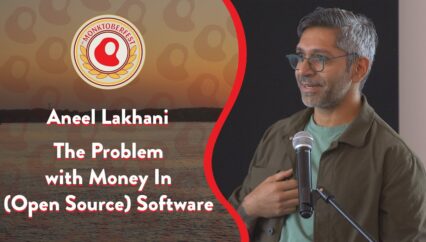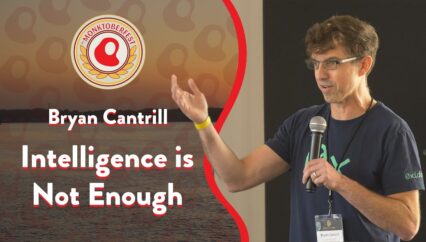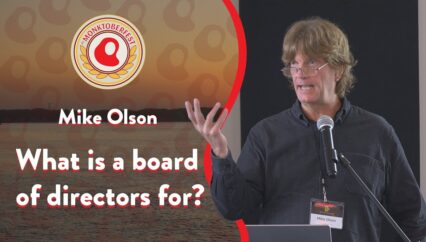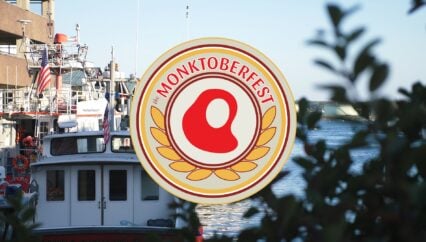In the wake of the Tōhoku earthquake on March 11, 2011, the Fukushima Daiichi nuclear disaster is often viewed as a failure in planning and preparedness. However, amidst this catastrophe, a hidden story of success emerged, led by plant director Masao Yoshida. Yoshida had cultivated a culture of trust and autonomy among his operators, who, without waiting for instructions, proactively worked to control the reactors despite lacking proper instrumentation. Their quick actions and Yoshida’s leadership in managing external pressures significantly minimized the potential radiation release. This narrative not only offers a thrilling tick-tock of looming disaster but also valuable lessons in teamwork, problem-solving, and decision-making under uncertainty, relevant to fields like software development. This compelling story highlights the importance of organizational culture in navigating crises, which is something every Monktoberfest attendee took away.
Transcript
Welcome to Monktoberfest. I have aspired to come to this event as long as I’ve been speaking at conferencings, so it’s a really big honor for me. I’m super-excited. Any name is Nick. I’m an engineer at Sym, but that is definitely not why I’m here. I’m here to tell you a story. Down along the coast of Japan, usually a significant distance from the water, are stones like this one left there by members of previous generations and they Saul say something pretty similar. This within specifically says, a home built high is children’s relief, remember the disastrous tsunami, do not build homes below here. These stones make it obvious that they’re no strangers to tsunamis. So given the risk of tsunamis, you might be surprised by where they built nuclear power plants in Japan. Every single one of them is on the coast. Why is that? When you picture a nuclear power plant, what comes to mind? It’s probably something like this, credit to the Simpsons, this is actually a fairly accurate renderrering of a nuclear power plant: Now, the funny thing about that is that there’s nothing inherently nuclear about these cooling towers, every thermal power plant needs a source of cooling and there are plenty of nuclear plants that use other kinds of towers. The post-war economic boom of Japan meant that by the 1970s, Japan was starving for electricity.
When you’re building nuclear power plants on a budget, one of the best ways is to build them near water and that’s what Japan did. One of the towers is Fukushima Daiichi, it’s located right on the Pacific coast in northeast Japan.
The reactors wept online between 1971 and 1979, all of them boiling water designs created by General Electric.
March 11th, 2011, started out like any other day at the plant. Units 1 and 3 were running as they say in the industry, hot, straight and. Units 5 and 6 were in preparation for a restart.
But off the coast of Japan in the Earth’s crust trouble had been brewing for more than 1,000 years. Potential energies built up like a spring and were compressed. On March 11, 2011, that potential energy finally overcame the friction holding it back and it became kinetic energy in the form of a 9.1 magnitude earthquake.
In this case, the fault line that ruptured roughly parallel to the northern coast of Japan. Northern Japan moved 8 feet closer to North America and the Earth’s axis shifted somewhere between 6 and 10 inches.
When the shaking started. Dr. Yoshida was in his office. Yoshida kept expecting shaking to taper off but it kept getting longer.
He ran out of his office and headed toward the plant’s emergency response center where he would spend the next several days. The control room was in disarray right after the quake. As the shaking stopped the officers immediately ran to the panels and calling out various measurements — they were able to quickly see that the plant’s automated emergency systems had done exactly what they were supposed to do. You need to know a little bit about how nuclear reactors work, so let’s do a quick crash course.
The heart of a nuclear power plant is the heat source. The fuel rods are contained surrounded about I water that, in a boiling water reactor boils to steam. There are also control rods that can be inserted to slow or stop the nuclear chain reaction. Water raises to steam, it expands and this is how the plant actually generates electricity. And finally there’s a circulation pump to send the cool water back into the bottom of the reactor pressure pump. There are sensors to detect earth movement. When there’s an earthquake, the reactor and control systems automatically scram immediately halting the nuclear chain reaction. This happened exactly as it was supposed to. But the fuel in a nuclear reactor gets so hot that you have to maintain cooling for several days after that shutdown to continue carrying heat away so that the fuel rods don’t melt. That means that the reactor’s circulation pumps must be kept running and that’s a problem when your plant is severed from the electrical grid.
Each reactor has two enormous backup generators. These generators had all started automatically as soon as it lost its connection, exactly as they were supposed to. In case the generators failed, each had a bank of acid batteries to give them control instrumentation for several hours.
Second, each reactor had a passive cooling vessel.
Could be directed through heat exchanger in the isolation tank where it could turn back to water and flow by gravity. The isolation could passively cool the reactor for three days without any intervention.
The other passive cooling systems started up aautomatically alongside the backup generators, now, at this point despite being without any external power, the plant was well on its way to a controlled shutdown.
When first tsunami warning went out. Never beyond the plant’s 19-foot sea walls. They made a precautionary announcement that a tsunami and people should move to higher ground, but that was the extent of their preparation.
In reality, the largest the of the threatens was more than 40 feet high and it was moving at 100 miles an hour. When it arrived, the operators had no idea. They were shocked when one of the operators announced a new critical warning.
The overhead lights in the control room went out, then slowly, randomly, panel by panel, the instruments flickered and went dark.
Constant alarm was replaced by an eerie silence.
A few seconds later, they had no electricity at all. The situation considered so impossible they had no realistic contingency plans for it. Now, the reacts are all 10 meters above sea level, well above the tsunami. The huge diesel backup generators, as well as the acid batteries were on the basement level. They were all flooded. The operators found themselves trying to operate three nuclear reactors that just minutes before were generating 2 gigawatts of power.
Cool about 20 minutes after the quake they realized that the reactor was cooling too fast. And so they began cycling the isolation on condenser on and off to slow down that cooldown. They had just cycled it off 3 minutes before they lost power. The passive cooling unit was completely without cooling.
Without cooling circulating to carry heat away, all of the water turned into boiling steam. First without water to cool t the nuclear fuel rods will not cool. Second, because water expands when it turns to steam, it will turn the condepser into a giant steam bomb. That could make Tokyo uninhabitable for decades, and that was in the back of everybody’s mind.
There were a few things they could do and they started working on them all at the same time. They knew the instruments in the control room were on DC power, so another team ran outside and started opening up the hoods of all the cars scavenging batteries.
A pair of operators headed into the dark reactor building to route the water from the pipes into the core. They accomplished their mission and were back in the control room by 9 p.m. By 11 p.m. radiation levels were so high that Yushido prohibited further entry.
By 2 a.m., they had a fire engine hooked up into the pipes and were pumping water into the reactor, cooling it, but this was very slow and once they had they understood why. Pressure in the pressure vessel was already at 2 atmospheres, they knew the only way that the pressure could possibly be this high in a reactor vessel is that the fuel had started to melt. So relieving the pressure was urgent.
Now, Yoshida was already working on this. Now, this is exactly what it sounds like, venting radioactive steam directly into the environment. In Japan law, — the Japanese Prime Minister immediately gave permission.
At the plant they had been working feverishly in rapidly deteriorating conditions. Radiation levels were now high enough in the control room that being there required wearing a full facemask with charcoal filters and if radiation levels were that high in the control room, imagine how they they have been in the reactor building. They had to figure out a way to vent in and out as quickly as possible.
Mean while, back in Tokyo, Kan announced the event. He was lived. It was 4 a.m. He had given his permission to vent hours ago, and he knew full well the consequences of the rising pressure. Why hadn’t the vent been done let? Liasons described to explain the challenges, but Kan decided he wasn’t seeing the necessary urgency from the staff. So at 5:30 in the morning, the day after the earthquake, the Prime Minister as entourage were on a helicopter. Offered standard Japanese business greetings, and Kan responded why the hell haven’t you vented yet? He proceeded to yell the entire bus ride and then when he got there the first time he did was greeted him by going, what the hell is going on here? But rather than fighting fire with fire, Yoshida explained. Finally Kan asked, when are you going to get the vent done? And Yoshida responded we are of course doing everything we can, we have a suicide squad. Hearing that there were people willing to risk their lives to conduct the vent operation, ended the discussion. Despite all the distractions that it caused, the actual meeting lasted less than 20 minutes. Meanwhile, there were a pathway to venting that only required opening two valves. Under Japanese law — everyone put on a personal alarm like this set to go off at 80, agreeing to turn back immediately if it went off. The first group made their way to the second floor of the reactor building. Huge, place, they got it done and were back in the control room in 11 minutes without coming anywhere close to the limits.
The second crew, though, was in a more precarious position. To help us understand, here’s a containment structure marked Mark I. If there had been core damage, it was likely that melted radioactive fuel would be sitting at the bottom creating an intense radiation field at the bottom of primary containment. As they made their way into the basement, the hand held radiation meter suddenly jumped to the maximum, so who knows how long it actually was, they were forced to turn back long before they got to the valve. Turns off the alarms were so noisy in the reactor basement that they couldn’t hear them.
The first two workers to dose out and had to be evacuated from the site.
At this point it’s nearly 10 a.m., the to despondent at the second crew’s discovery, but they didn’t give up. There had to be a way to vent T one team worked to see if a portable air compressor could remotely operate the pneumatic valve valve. By 2 in the afternoon it was up to 8 atmospheres in pressure, just about double its rated failure strength. Things were getting desperate.
Another group was getting ready to make a run at the valve when they got a call from the emergency response center. White smoke was coming off the top of 1 and 2 stack. Slowly the pressures in the reactor started to drop. They must be venting, there’s no way they could have known it without instrumentation, but the attempt to open the valve pneumatically must have worked. They felt a tremendous sense of relief and they were able to enjoy that sense of relief for less than an hour.
This is what monitoring unit 1 saw 3:30 a.m. Their ininstrument was venting the reactor was too little too late. But thankfully that wasn’t what had happened. The fuel rods are tubes made zirconium alLoy. It losses its ability to lose corrosion and starts rapidly corroding and this rapid corrosion rips the water molecules into zirconium oxide and hydrogen gas. As the smoke and debris settled, thises what they saw. It’s likely there were plenty of places the hydrogen could have slipped through. It accumulated at the top of the control building and all it took is one spark. The explosion blew radioactive debris across the site. The work of keeping units 2 and 3 from overheating and melting down got that much harder.
And the situation at Unit 3 was getting critical. The passive cooling system was working, but heat was starting to build and they were running out of fresh water on site. So the team made the call to start injecting sea water. They had been trying to avoid this, because the salt would ruin the reactor, meaning it would never generate power again, but they had to keep it from exploding. Back in Tokyo, the Prime Minister demanded that they not do it. One of a small group of technical advisors had mentioned a non-zero chance that the salt in the sea water might cause the reactor to start reacting again.
Kan was insistent that they investigate further before moving forward. Yoshida has no intent of complying.
He told his staff, if they order me to halt sea water injection, I will relay the order so that they can hear me. you can not to respond and you are not to stop sea water injection, it’s our only chance. Unbeknownst to them, core damage had already occurred and if they had halted the sea water injection, it likely would have exploded.
Unit 4 which wasn’t even running at the time of the earthquake would also have its own hydrogen explosion from hydrogen gas suspected to leak over from Unit 3.
You can see Units 1 through 4 in this photo. Three exploded, three in a point of partial meltdown. It was hazardous to walk from building to building with staff in protective gear anywhere they wanted to go onsite.
So Yoshida made the difficult decision to evacuate most of the staff. And only keep a volunteer skeleton crew onsite. Everyone who chose to say knew there was a significant chance they’d suffer dangerous radiation exposure, possibly even die, but they felt a responsibility to the rest of Japan to make sure the explosion didn’t cause wider contamination.
Back in Tokyo, Prime Minister Kan hears that they are going to abandon the plant. It doesn’t matter, Kan is livid. He uses his authority to create a joint response office with him as the head, taking over the control Yukushima, you must risk your libraries on it if necessary, if you abandon the plant, TEPCO will be destroyed. You can run, but you’ll never get away. To a roomful of people who had just decided to sacrifice their lives if necessary, to keep the plant from exploding, Kan said, you can run, but you’ll never get away.
Well, at this point, Yoshida had had enough. At the front of the room, video cameras still running, he stands up, turns his back to the camera, and drops his pants.
Now, he makes it look like he’s just tucking his shirt back in, but everybody in the room knows what he’s really doing. In Japan’s business culture, turning your back on a superior is a sign of disrespect and Yoshida took it to the next possible level.
Now, as 9 plant slowly came under further control and workers came trickling back to help.
It took over a year. This photo taken earlier this year shows the condition of the plant today. A tank farm is unit 1 and 2s buildings were able to be repaired, but new containment structures had to be built. Decommission work has begun and will likely take several decades to complete.
The history of nuclear power generation, thereof only been five meltdowns, threw of them at Fukushima.
The first commissioner reactor partial meltdown was at Three Mile Island: Fukushima Daiichi, is estimated to have to have released 780 peta b.
But the correct size would actually be a circle 6 10 millionths of a pixel across.
Now, the worst of all times, Chernobyl.
There was nothing preventing that from going straight up into the atmosphere. But let’s say the operators at Fukushima had failed to establish cooling and all three running units experienced steam explosions.
An uncontained failure in all three active Fukushima units is estimated to have released at least 7.5fepta …
It’s almost impossible to know how bad it could have been if not for the reactions of the actions of all the people who risked their personal safety. The only way was to move the backup generators to higher ground, something that in true bureaucratic fashion, was being studied but hadn’t been committed to at the time of the accident.
But there’s very little they could have done better in the minutes, hours, and days after the accident. We think of Fukushima Daiichi as an accident, and it was, but when you look at it, it was also an incredible success. So instead of looking at what went wrong, let’s look at what went right.
With the Prime Minister breathing down their necks, the operators at Fukushima were able to think creatively and operate diseasively to bring the plant back upped control.
To understand we have to look at how organizations actually happen. This paper is by Dr. Heis en to start.
Documenting the steps, conversations, tools, and other activities required, to do something like processing an insurance claim to launch a new product into the market. These maps always surprised the teams that created them. And they often raised existential questions, especially for the people with leadership titles.
The reason was that they revealed the actual structure of the organization.
The relationships and information pathways that were responsible for the organization they worked on.
To quote GHising, … they learned that what they had previously attributed to the direction and control of centralized, bureacratic forces was actually …
Now, it’s
Dr. Hising’s work tells us that control is not exactly what these give us. All of the organization happens apartment the bottom of the organization or the edges of the organization. This is where the organic structure where an organization actually gets its work done exists. As a leader, the chrome is actually an illusion made up of two things. The first is power. Depending on your mold, your formal authority might give you control over people’s pay, what projects they get to work on and sometimes even whether they continue to have a job. This power can give you a lot of leverage in getting people to do what you want them to do. The next one is influence, the expertise that you display, and the behaviors that you model to engender trust in the people that you work with, to align them with the mission.
Every leader uses a combination of power and influence to get the job done. The more influence you use to lead, the less power you use, and vice versa, I should clarify that you don’t have to have a formal leadership title for this to be true. The fact that you would choose to come to an event like this, tells me that this probably applies to everybody in this room. There are people who will look up to you as an organizational leader, even if you don’t have the title.
Let’s take a look at the two leaders, and put them on a spectrum. In a 1998 paper, Dr. Westrum proposed in a paper. Is it pathological? Is it bureaucratic, following a set of rules, or is it generative, flowing freely to advance the whole organization’s goals. Westrum provides found the influence of leaders was most evident at the extremes and that bureaucratic organizations were sort of an unfortunate default. So we’re going to ignore bureaucratic day. What are some of the — pathological leaders build cultures with low levels of cooperation, by making sure all decisions flow through them.
Generative leaders, encourage cooperation by delegating authority to those closest to the situation. Pathological leaders tend to shoot messengers yelling at them for not solving the problem.
Generative leaders, when something go wrong, pathological leaders make sure they know who to blame so they don’t get blamed themselves. Generative leaders aren’t that worried about blame. They want to understand what’s happened, so they can respond to it and learn from it.
Generative leaders try to get their whole team into the idea-generating business, because they know they don’t have a monopoly on good ideas.
Westrum said: A generative culture will make the best use of its assets …
The generative culture that Yoshida is the reason the operators were able to creatively resolve so many problems happening at the same time. So how did he do it? Masao Yoshida most of them answered we would have been lost without him. Some of them said, with Yoshida in the lead, we were prepared to die together if we had to. And when asked why, it came down to trust. Yoshida Yoshida continually reearned and reinforced that trust by doing things like standing up to the Prime Minister, managing technical leaders in Tokyo, making time and space for his team to respond to the events in front of him.
If you want to build this kind of culture, among those you work with, those you lead, start embracing the idea that you’re not actually in control as a leader, you’re just building power and building influence. You have to decide where you want to land on this spectrum and if you want to build a generative structure, there’s a pretty clear answer. That’s not to say that all power is pathological. But in general, leading by influence means that you lead by being worth following.
You have to build trust, share context, build buy-in, encourage and motivate rather than just telling people what to do. It means actively giving your power away to those you lead, make using power to lead feels so much easier sometimes. But this was the secret of Yoshida. He was a leader worth following and it’s not an overstatement to say that the generative culture his team built is the thing that allowed them to save Tokyo.
There’s nothing stopping us from doing the exact same thing!
[applause].












